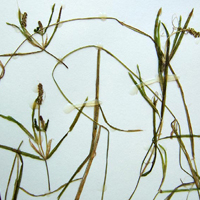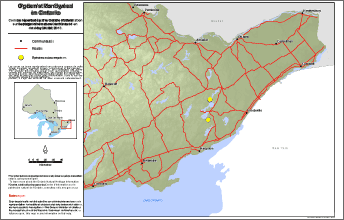Ogden’s Pondweed
Scientific name: Potamogeton x ogdenii

Cover photo credit: Davis Lock, Department of Agriculture
Status
Endangered
Endangered
means the species lives in the wild in Ontario but is facing imminent extinction or extirpation.
Date added to the Species at Risk in Ontario list
February 18, 2009
On January 26, 2022, the scientific name of this species was updated on the Species at Risk in Ontario list from Potamogeton ogdenii to Potamogeton x ogdenii to be consistent with recent taxonomic changes. This name change does not change the protections afforded to the species under the Endangered Species Act, 2007 or the applicability of any policies, permits and agreements, guidance documents – including recovery guidance – or best management practices that have been published or issued by the Government of Ontario in respect of the species.
What it looks like
Ogden’s pondweed is an underwater plant with branching, thread-like stems. It has narrow, greenish-brown leaves five to seven centimetres long. It looks very similar to other pondweed species and can be hard to identify correctly.
Where it lives
In Ontario, Ogden’s pondweed is found in clear, slow-moving streams, beaver ponds and lakes.
It often grows with other species of narrow-leaved pondweeds, which can make identification of this rare plant even more difficult.
Where it’s been found in Ontario
In Canada, Ogden’s pondweed is found only in southeastern Ontario. It was recorded at Murphys Point Provincial Park and Davis Lock on the Rideau Canal between 1970 and 1990.
A historical sighting of the species was recorded in Hastings County in 1873. It has been recommended that additional surveys are needed to determine whether this species exists at any other sites in Ontario.
Outside of Canada, Ogden’s pondweed has been identified in Connecticut, New York, Vermont and Massachusetts.
View a Larger version of this map (PDF)
What threatens it
The main threats to Ogden’s pondweed are habitat destruction and competition from invasive aquatic plants such as Eurasian Water-milfoil.
Low population numbers make this species more susceptible to extinction. There is still much to learn about the biology of this rare plant, its habitat needs and threats.
Action we are taking
Endangered Species and their general habitat are automatically protected.
Recovery strategy
A recovery strategy advises the ministry on ways to ensure healthy numbers of the species return to Ontario.
Read the executive summary (February 18, 2010)
Read the recovery strategy (February 18, 2010)
Government response statement
A government response statement outlines the actions the government intends to take or support to help recover the species.
Read the government response statement (November 18, 2010)
Five-Year Review of Progress
A five-year review reports on progress made toward protecting and recovering a species, within five years of publishing a species’ government response statement.
Read the report on progress towards the protection and recovery of 13 species at risk, including Ogden’s Pondweed (2015)
Habitat protection
A habitat regulation defines a species' habitat and many describe features (for example, a creek, cliff, or beach), geographic boundaries or other unique characteristics.
Read the regulation (July 1, 2011)
What you can do
Report a sighting
- Report a sighting of an endangered animal or plant to the Natural Heritage Information Centre. Photographs with specific locations or mapping coordinates are always helpful.
Volunteer
Volunteer with your local nature club or provincial park to participate in surveys or stewardship work focused on species at risk.
Be a good steward
- private land owners have a very important role to play in species recovery; if you find Ogden’s pondweed on your land, you may be eligible for stewardship programs that support the protection and recovery of species at risk and their habitats
- invasive species seriously threaten many of Ontario’s species at risk; to learn what you can do to help reduce the threat of invasive species, visit:
- soil erosion and runoff introduces pollutants such as fertilizers and pesticides to watercourses in Ontario; there are many things that you can do to help reduce these effects and you might even be eligible for funding assistance; for more information on these and other programs, contact the Ontario Soil and Crop Improvement Association
Report illegal activity
Report any illegal activity related to species at risk to
Quick facts
- Ogden’s pondweed was named after pondweed specialist Dr. Eugene Ogden
- pondweeds provide habitat for aquatic invertebrates (a very important group of creatures in the aquatic food chain), food for mammals and waterfowl, and hiding places for amphibians and fish
- unlike many other plants that reproduce primarily by seeds, Ogden’s pondweed reproduces mainly by producing special winter buds called
turions
; these buds grow at the ends of stems and fall to the lake bottom, where they spend the winter and start growing new plants in the spring
